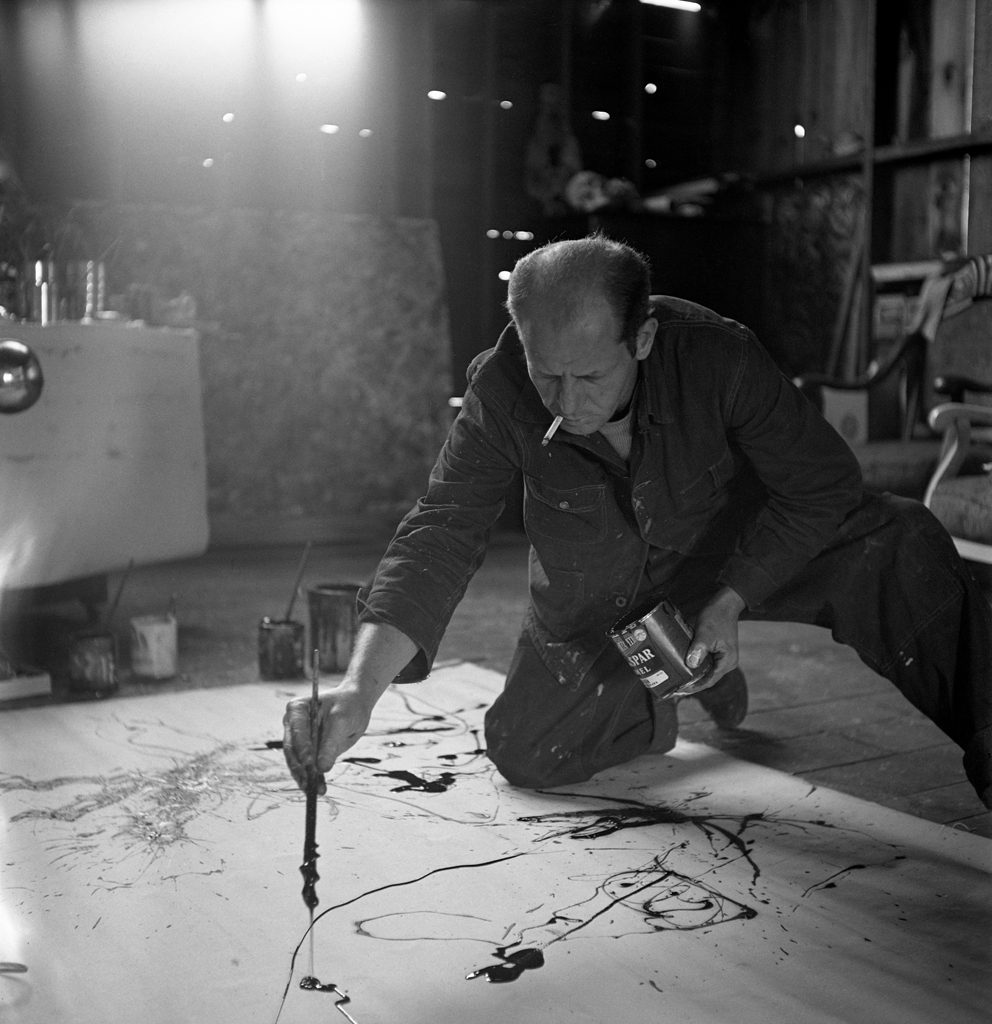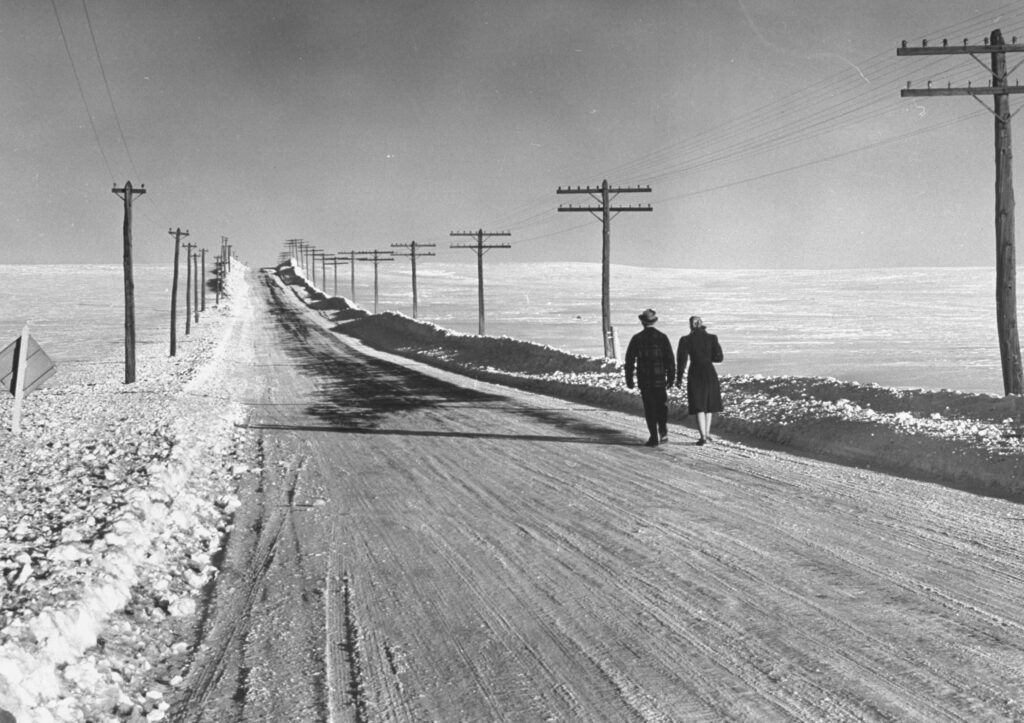Written By: Ben Cosgrove
Is he the greatest living painter in the United States?
That was the direct, provocative question asked in an August 1949 LIFE magazine article that helped cement Jackson Pollock’s reputation. It was a question Pollock spent much of the rest of his life struggling to answer while desperately hoping to show the skeptics why LIFE was right to even ask such a monumental question in the first place.
As the single most recognizable practitioner of Abstract Expressionism—the movement that put America and, specifically, post-World War II New York at the epicenter of painting’s avant-garde—Pollock was a genuine art star. But he soon abandoned the radical “drip” technique that had earned him both fame and, among some art critics, vilification and spent the last few years of his life battling the twin demons of depression and alcoholism.
Here, LIFE presents outtakes from photographer Martha Holmes’ 1949 shoot with Pollock images that offer a unique portrait of the artist’s home life with wife and fellow painter Lee Krasner on eastern Long Island, and the singular working method that made him an art-world icon.
With a down payment loaned to them by art dealer Peggy Guggenheim, Pollock and Krasner bought land in the hamlet of Springs, New York, and moved into the house that would be Pollock’s residence for the last decade of his life. Pollock converted a small nearby barn into a studio, where he was to create many of his most famous works. As his fame grew, the little town of Springs — part of East Hampton—attracted other major artists and writers, including Willem de Kooning, Kurt Vonnegut, Nora Ephron, Philip Roth and Joseph Heller.
Despite moving out of the city to live on a farm near the ocean, it’s hard to say that nature was an inspiration for Pollock’s paintings, which were so abstract that their only apparent source was the artist’s subconscious. Still, the natural world did find its way into his paintings in the form of sand and other materials that the artist routinely applied to his canvas, along with his paints, while the titles of some work—like his gargantuan Autumn Rhythm (1950)—reflect a sensibility attuned to the seasons.
Pollock’s work was often referred to as “action painting,” and the dance-like performance in which he engaged while making a painting was integral to the aesthetic result. Instead of using an easel, he’d stretch a canvas on the floor of his barn and scamper around all four sides as he painted. Rather than using brushes, he used sticks to flick and drip paint, or he poured it straight from the can, favoring household enamels over traditional oils.
Today, a painting from Pollock’s “drip period” can fetch north of $100 million at auction.
After he became famous and successful, Pollock bought his own open-air carriage, a 1950 Oldsmobile 88 convertible. This was the vehicle he was driving on August 11, 1956, when, less than a mile from his house, he drove off the road and flipped the car, killing himself and a passenger, Edith Metzger, and injuring his mistress, Ruth Kligman.
Krasner, a talented abstract painter in her own right, had put her career on hold during decade with Pollock in the Long Island house in order to support her husband’s career. After his death, she began painting in the barn that had been his studio. By the time she died in 1984, at age 76, she was finally recognized for her own work, and not merely as “Mrs. Jackson Pollock.” Today, the farmhouse and barn studio comprise a museum devoted to the study of the married painters’ intertwined working lives.
Liz Ronk edited this gallery for LIFE.com. Follow her on Twitter @lizabethronk.

Jackson Pollock worked in his Long Island studio, 1949.
Martha Holmes/Life Pictures/Shutterstock

Jackson Pollock and Lee Krasner, Long Island, April 1949.
Martha Holmes/Life Pictures/Shutterstock

Jackson Pollock and neighbor, 1949.
Martha Holmes/Life Pictures/Shutterstock

At Daniel Miller’s general store in Springs, New York, Lee Krasner and Jackson Pollock talked with Tino Nivola, a new arrival at the artist colony that began to sprout around the Pollocks’ Long Island village in the late 1940s.
Martha Holmes/Life Pictures/Shutterstock

Jackson Pollock, Long Island, 1949.
Martha Holmes/Life Pictures/Shutterstock

Jackson Pollock worked in his Long Island studio, 1949.
Martha Holmes/Life Pictures/Shutterstock

Jackson Pollock worked in his Long Island studio, 1949.
Martha Holmes/Life Pictures/Shutterstock

Jackson Pollock admired the watercolors of neighbor Mary Monteverdi, a self-taught artist inspired to take up painting after seeing Pollock’s work.
Martha Holmes/Life Pictures/Shutterstock

Grocer Daniel Miller (left) visited Pollock and Krasner at their Long Island farmhouse, 1949.
Martha Holmes/Life Pictures/Shutterstock

Neighbor Nathaniel Edgar Talmadge (age 84) and his horse Rowdy Kate (age 21) stopped by for a chat with Jackson Pollock and Lee Krasner in April 1949.
Martha Holmes/Life Pictures/Shutterstock

Jackson Pollock dried dishes with Lee Krasner in the kitchen of their farmhouse, 1949.
Martha Holmes/Life Pictures/Shutterstock



















